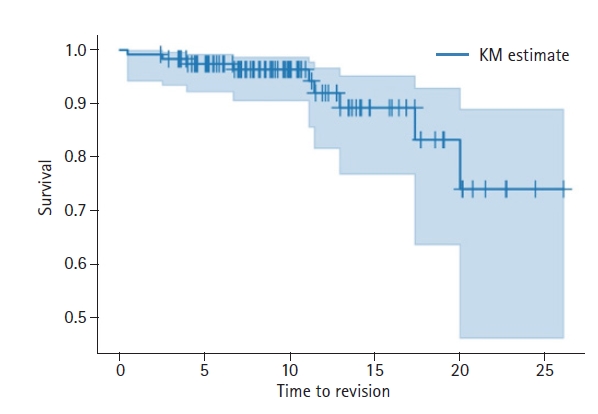 |
 |
- Search
| Clin Shoulder Elb > Volume 26(3); 2023 > Article |
|
Abstract
Background
Methods
Results
NOTES
Author contributions
Conceptualization: TL, AHD, CAW, DS, BOP, ELF, PJC. Data curation: CMC. Formal analysis: TL, CAW, AP, AVP, BZ, CSW, AW, CMC. Methodology: TL, AHD, CAW. Resources: AP, AVP, BZ, CSW, AW, CMC. Supervision: DS, BOP, ELF, PJC. Writing – original draft: TL, AHD, CAW, AP, AVP, BZ, CSW, AW, CMC. Writing – review & editing: DS, BOP, ELF. PJC.
Conflict of interest
Dave Shukla is a consultant for Stryker, Tornier, and Wright Medical Technology; Bradford O. Parsons: consultant for Arthrex; Evan L. Flatow: Board and/or Committee Member of American Shoulder and Elbow Surgeons and Health Association of New York, and IP royalties from Innomed, Publishing royalties and financial and/or material support from Springer; Paul J. Cagle: consultant for Stryker, Johnson & Johnson, and Arthrex. No other potential conflicts of interest relevant to this article were reported.
Fig. 1.

Table 1.
Table 2.
| Outcome | Preoperative | Postoperative | P-value |
|---|---|---|---|
| Forward elevation (°) | 118.38±24.23 | 148.58±22.07 | <0.001 |
| External rotation (°) | 20.54±23.88 | 55.70±15.91 | <0.001 |
| Internal rotation* | 6.08±3.83 | 11.04±3.71 | <0.001 |
| ASES score | 33.85±19.21 | 76.54±22.72 | <0.001 |
| SST score | 3.05±2.55 | 8.49±3.21 | <0.001 |
| VAS pain score | 6.31±2.47 | 1.96±2.60 | <0.001 |
Table 3.
| Outcome | N* | β† | 95% CI | P-value |
|---|---|---|---|---|
| Postoperative ASES score | 112 | 0.46 | –0.02 to 0.94 | 0.059 |
| Postoperative VAS pain score | 112 | –0.05 | –0.10 to –0.01 | 0.080 |
| Postoperative SST | 113 | 0.01 | –0.06 to 0.08 | 0.733 |
| Postoperative FE (°) | 116 | 0.11 | –0.36 to 0.58 | 0.656 |
| Postoperative ER (°) | 114 | –0.28 | –0.62 to 0.06 | 0.103 |
| Postoperative IR (°) | 111 | 0.10 | 0.02 to 0.18 | 0.011 |
Table 4.
| Outcome | N* | β† | 95% CI | P-value |
|---|---|---|---|---|
| Postoperative ASES score | 112 | 0.63 | 0.11 to 1.14 | 0.018 |
| Postoperative VAS pain score | 112 | –0.08 | –0.14 to –0.02 | 0.012 |
| Postoperative SST | 113 | 0.05 | –0.02 to 0.13 | 0.143 |
| Postoperative FE (°) | 116 | 0.04 | –0.48 to 0.56 | 0.893 |
| Postoperative ER (°) | 114 | –0.37 | –0.74 to 0.01 | 0.055 |
| Postoperative IR (°) | 111 | 0.06 | –0.03 to 0.15 | 0.172 |
Table 5.
| Outcome | N* | β† | 95% CI | P-value |
|---|---|---|---|---|
| Postoperative ASES score | 96 | 0.69 | 0.11 to 1.27 | 0.019 |
| Postoperative VAS pain score | 96 | –0.08 | –0.14 to –0.01 | 0.028 |
| Postoperative SST | 96 | 0.07 | –0.01 to 0.15 | 0.090 |
| Postoperative FE (°) | 101 | 0.05 | –0.51 to 0.62 | 0.851 |
| Postoperative ER (°) | 99 | –0.30 | –0.71 to 0.11 | 0.155 |
| Postoperative IR (°) | 97 | 0.07 | –0.02 to 0.17 | 0.130 |
BMI: body mass index, ASA: American Society of Anesthesiologists, CI: confidence interval, ASES: American Shoulder and Elbow Surgeons, VAS: visual analog scale, SST: Simple Shoulder Test, FE: forward elevation, ER: external rotation, IR: internal rotation.
REFERENCES
- TOOLS
-
METRICS

-
- 0 Crossref
- 1,275 View
- 29 Download
- Related articles in Clin Should Elbow
-
Use of custom glenoid components for reverse total shoulder arthroplasty2023 December;26(4)
Variability in physical therapy protocols following total shoulder arthroplasty2023 September;26(3)
Soft-tissue coverage for wound complications following total elbow arthroplasty2021 December;24(4)
Evaluating Scapular Notching after Reverse Total Shoulder Arthroplasty2015 December;18(4)







